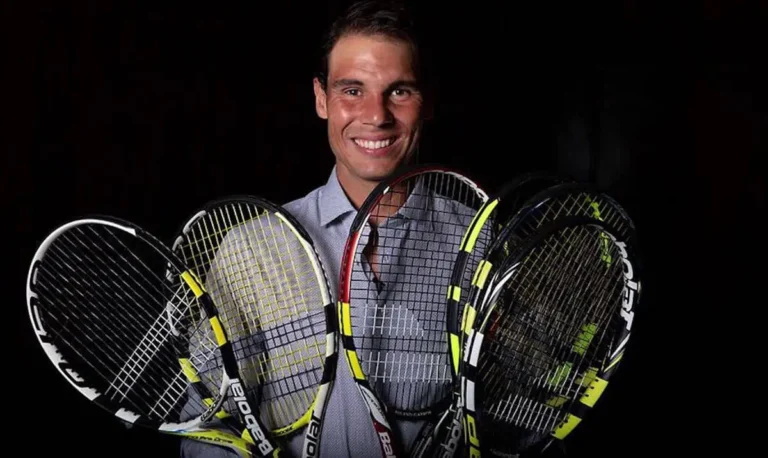Have you ever wondered why tennis players have multiple rackets in their bag? Or wondered when you turn up to play your club opponent they pull out three rackets and line them up next to the court?
Is this an intimidation tactic or is there a reason to it?
Why Do Tennis Players Have Multiple Rackets?
Tennis players carry multiple rackets to a match for several practical reasons. The main reason is that if one racket breaks or the string breaks then they have a spare to transition to.
High-level tennis involves powerful strokes that can lead to string damage during play. By having several rackets available, a player can continue the match with minimal disruption, ensuring they always have a reliable racket at hand. How often have you been caught out not having a spare racket, I know I have.
Another consideration is the subtle variances in string tension that can affect a player’s game. Tennis professionals often adjust the string tension on their rackets to suit specific playing conditions, like temperature and surface type.

Different tensions can cater to various shots and strategies; some players prefer tighter strings for control on faster courts, while others opt for looser strings for more power. Maintaining multiple rackets, each with a particular string setup, can provide tactical flexibility during a match.
You will see many of the professionals change rackets when their are new balls. New balls move faster through the air and players normally want a new racket that has a tighter tension to respond to this.
Another reason is the wear and tear on grip tape from a player’s hands that can affect their hold and comfort. Multiple rackets mean fresh grips are always available, reducing the potential for slippage and ensuring maximum comfort and control. This factor, though less often discussed, can have a significant impact on a player’s ability to perform consistently well throughout a long match.
Fundamentals of Tennis Equipment
When examining the core aspects of tennis gear, it’s crucial to understand the mechanics behind racket technology and the implications of string tension on a player’s game. These fundamentals can significantly influence a tennis player’s performance on the court.
Racket Technology and Customization
Modern tennis rackets offer a range of advancements that allow for extensive customization to fit a player’s needs. Racket technology incorporates materials such as carbon fiber and graphite which contribute to the equipment’s lightness and strength.
The specific composition of a racket can affect the power and control a player has over their shots. Some players might prefer a heavier racket for added stability, while others opt for lighter models for greater maneuverability.
Customization is evident through choices in racket head size, balance, and grip size. Head size dictates the power and sweet spot of a racket; a larger head size results in more power but less control, whereas a smaller head size offers greater control at the expense of power.
Balance relates to how weight is distributed in the racket. Variations include head-heavy, even-balance, or head-light. The grip size must comfortably fit a player’s hand to prevent injuries.
String Tension and Performance
String tension has a direct impact on racket performance and can be manipulated to suit a variety of playing styles and conditions. Higher tension typically results in more control and accuracy, while lower tension can increase power and the trampoline effect of the ball off the racket. Players may alter their string tension based on factors such as gameplay, weather conditions, or personal preference.
Strings are also selected based on characteristics such as durability, feel, and playability. Materials like natural gut, nylon, and polyester offer different benefits. For instance, natural gut provides excellent tension retention and a soft feel, yet is less durable than synthetic options like polyester, which provides durability and is favored for its ability to facilitate heavy spin.
Players often carry multiple rackets with different string setups to be prepared for the unexpected, such as a sudden change in weather or a broken string during an important match. Having several rackets at hand ensures that they can maintain their level of play without interruption.

What Else Do Players Keep In Their Bags?
Beyond rackets, player bags typically house a range of items for performance and comfort. These include fresh overgrips for optimal handle traction, dampeners to reduce string vibration, extra strings, towels, sunglasses, sports drinks for hydration, energy gels, and personal effects such as wristbands, hats and spare clothing.
Frequently Asked Questions
The complexities of professional tennis involve more than strategy and skill; equipment also plays a crucial role. Here, common queries about why and how tennis players manage multiple rackets during matches are addressed.
What is the reason behind tennis players switching rackets during matches?
Tennis players switch rackets to adapt to changes in string tension and playing conditions. High-level players are sensitive to the slight variances that can affect their game and may change rackets to maintain optimum performance.
How often do professional tennis players use new rackets in a single match?
Professionals may use a new racket every 9-12 games, typically when new balls are introduced, to match the precise conditions that affect play, such as ball speed and response.
Why do tennis players inspect several rackets before selecting one?
Tennis players inspect several rackets to find the one with the preferred string tension and grip feel. Small differences can greatly impact their control and confidence in their shots. For me it is gut feel when I pick a racket up if I like it or not.
How does the number of rackets a tennis player has affect their game?
Having multiple rackets ensures that players are prepared for string breakages and can stay equipped with freshly strung rackets, which offer consistent performance throughout the match.
Is there a specific reason players prefer certain rackets when new balls are brought into play?
Players often switch to rackets with tighter string tensions when new balls are introduced to counteract the increased bounce and speed of fresh balls, allowing them to maintain control over their shots.
What are the regulations regarding the number of rackets a player can have at tournaments like Wimbledon?
Tournament rules, like those at Wimbledon, typically do not limit the number of rackets a player can have during a match, allowing them to bring as many as they feel necessary to maintain optimal performance.
Final Thoughts
I do believe that all players should have a spare racket where possible. If you are a club player there is a good chance a string breaks and you want to be able to carry on playing.
Professional players have multiple rackets in their bag. The change in racket normally comes to adapt to new balls when receiving serve but each player has their own preference. Some players are also superstitious and will change at certain times.
Rackets rarely get broken in matches (although Bublik and Kyrgios do from time to time smash them!) and rackets may be changed if grips have become worn or too wet from sweat.




Comments are closed.